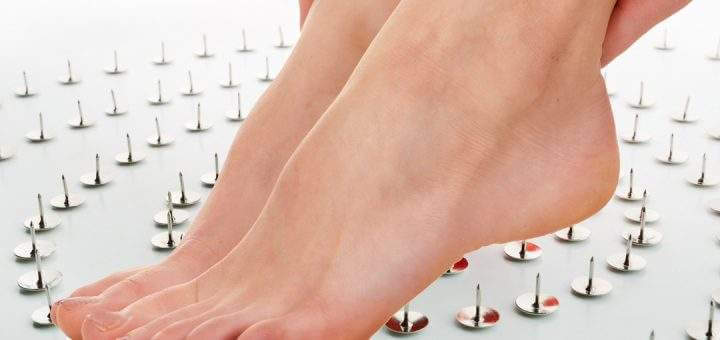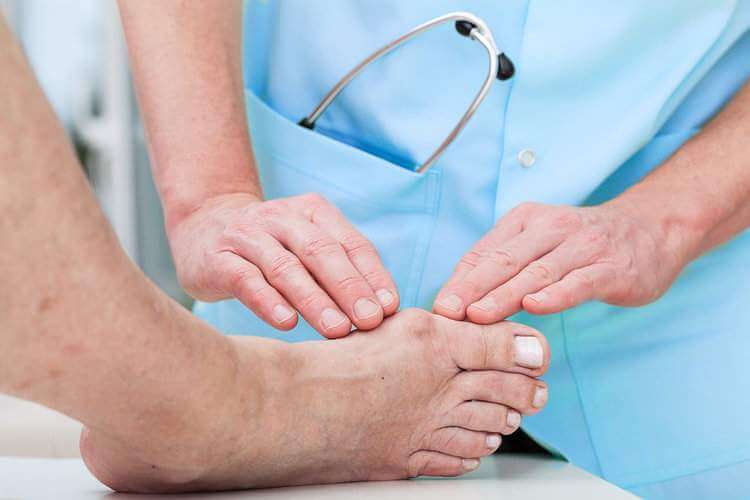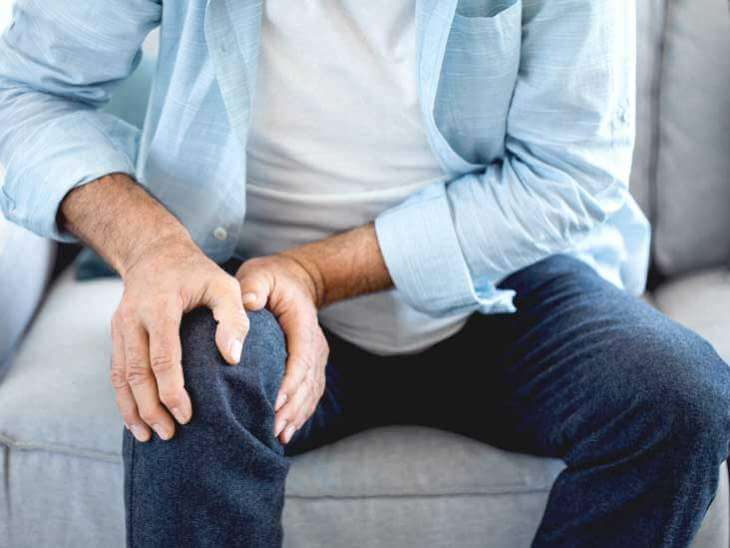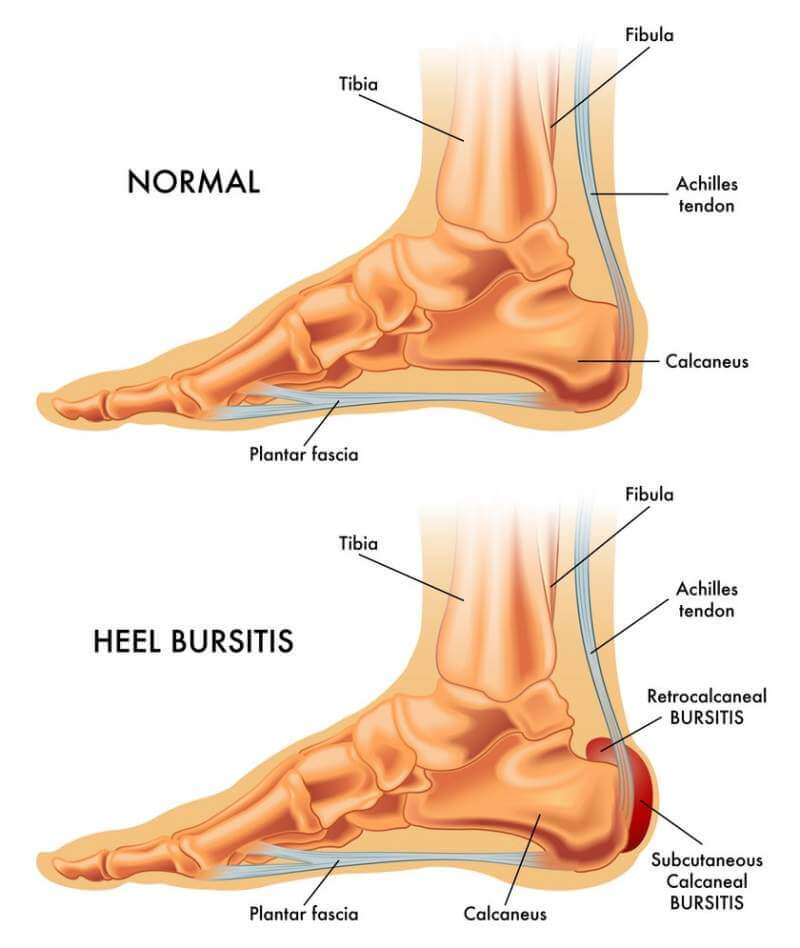The ankle is a complex joint made out of bones, tendons, ligaments, and cartilage. Its role is to support the bodyweight while standing, walking, and running. Ankle injuries are very common due to various reasons and may lead to ankle pain when walking.
In most cases, ankle pain when walking will result due to an injury of the ankle joint because of a fall, or while playing certain types of sports like football, basketball, volleyball, etc. However, any kind of injury can lead to ankle pain. Even walking can lead to ankle pain, especially if you are overweight or obese, or if you had an ankle joint injury in the past. Injuries that will lead to ankle pain when walking are bruises, sprains or strains, and of course fractured bones of the ankle joint.
However, some medical conditions can lead to ankle pain when walking as well. These conditions include:
Peripheral neuropathy
 Peripheral neuropathy which is a condition characterized by damage to the peripheral nerves due to chronic diseases like diabetes, trauma, infections, tumor, etc.
Peripheral neuropathy which is a condition characterized by damage to the peripheral nerves due to chronic diseases like diabetes, trauma, infections, tumor, etc.
Gout
 Gout is a condition characterized by the accumulation of the uric acid in the ankle joint. Uric acid instead of dissolving into the blood and getting eliminated from the body will end up crystalized and starts accumulating in the joints, including the ankle joint.
Gout is a condition characterized by the accumulation of the uric acid in the ankle joint. Uric acid instead of dissolving into the blood and getting eliminated from the body will end up crystalized and starts accumulating in the joints, including the ankle joint.
Osteoarthritis
 Osteoarthritis is one of the most common forms of arthritis that affects the ankle joint. It is a medical condition characterized by the breakdown of cartilages in the joints. As you get older, the condition will get worse along with the pain it causes. Your problem will get even worse if you are overweight or if you had any previous injury to the ankle.
Osteoarthritis is one of the most common forms of arthritis that affects the ankle joint. It is a medical condition characterized by the breakdown of cartilages in the joints. As you get older, the condition will get worse along with the pain it causes. Your problem will get even worse if you are overweight or if you had any previous injury to the ankle.
If your ankle hurts in the back then it could be another problem causing it. Medical conditions that can cause heel pain include:
- Heel bursitis
- Achilles tendinitis
- Achilles tendon rupture
Heel bursitis
 Heel bursitis is an inflammation of the bursa which is located between the skin at the back of the heel and the Achilles tendon or in front of the place where the Achilles tendon gets attached to the heel bone. Heel bursitis is categorized into posterior bursitis or anterior bursts based on which bursa is affected. But, what is a bursa? A bursa is a fluid-filled sack that acts as a cushion around the joint protecting it during movement.
Heel bursitis is an inflammation of the bursa which is located between the skin at the back of the heel and the Achilles tendon or in front of the place where the Achilles tendon gets attached to the heel bone. Heel bursitis is categorized into posterior bursitis or anterior bursts based on which bursa is affected. But, what is a bursa? A bursa is a fluid-filled sack that acts as a cushion around the joint protecting it during movement.
Any strenuous activity or overuse of the specific joint can lead to bursitis. Signs and symptoms of heel bursitis include heel and ankle pain, skin redness on the back of the heel, swelling, as well as pain when walking and especially when standing on the toes. Treatment includes ice compresses, over the counter painkillers and avoiding physically stressful activities in the future.
Achilles tendinitis
 Achilles tendinitis, otherwise commonly known as Achilles tendinopathy is a common problem especially for runners who suddenly increase their intensity or duration of their runs. It is caused by the overuse of the Achilles tendon. This tendon is the largest tendon in the human body that cones the calf muscles at the back of the lower leg to the heel bone.
Achilles tendinitis, otherwise commonly known as Achilles tendinopathy is a common problem especially for runners who suddenly increase their intensity or duration of their runs. It is caused by the overuse of the Achilles tendon. This tendon is the largest tendon in the human body that cones the calf muscles at the back of the lower leg to the heel bone.
Signs and symptoms of Achilles tendinitis include joint and muscle stiffness, tenderness, and pain in the back of the ankle and calf area. The pain can vary from mild, moderate or severe, depending on the extent of the injury to the Achilles tendon. Treatment usually includes rest, the elevation of the affected ankle and leg. Hot and cold compresses are also recommended.
Achilles tendon rupture
 Achilles tendon rupture is a condition characterized by the rupture of the Achilles tendon. Those engaging in certain sports are more likely to end up with this type of injury. Signs and symptoms include pain and swelling around the heel, inability to bear the weight on the affected foot, calf pain, pain when walking, etc. The treatment and its prognosis will depend on the severity of the injury.
Achilles tendon rupture is a condition characterized by the rupture of the Achilles tendon. Those engaging in certain sports are more likely to end up with this type of injury. Signs and symptoms include pain and swelling around the heel, inability to bear the weight on the affected foot, calf pain, pain when walking, etc. The treatment and its prognosis will depend on the severity of the injury.
Complete ruptures of Achilles tendon will be harder to treat compared to partial tears of this tendon. The recovery period will be longer as well. Treatment can be either non-surgical or surgical. Physical therapy is also necessary to get back the normal function of the affected ankle, regardless if this injury is treated non-surgically or surgically. Physical therapy will help to strengthen and to stretch the muscles which will provide more support and stability to your ankle.
Non-surgical treatment
 The solution to your problem will depend on the underlying cause of your ankle pain. In any case, if you notice ankle pain when walking, especially after an injury or a fall, you should seek medical help and get the right diagnosis. Once you have the diagnosis, your ankle pain treatment can start.
The solution to your problem will depend on the underlying cause of your ankle pain. In any case, if you notice ankle pain when walking, especially after an injury or a fall, you should seek medical help and get the right diagnosis. Once you have the diagnosis, your ankle pain treatment can start.
If you are overweight or obese, it is very important for you to start losing some weight as soon as possible which will be beneficial not only to the ankle bones but to your entire body.
If there is a bruise, sprain, or strain causing ankle pain when walking, you will need to support the ankle correctly, ice it, elevate it properly and rest for a one or two weeks. This will give enough time for your ankle joint to fully recover. If the pain is more than you can handle, over the counter painkillers may help.
Surgical treatment
 In cases of fractured bones, your treatment will be a little bit more complicated and sometimes even surgical treatment might be necessary. Surgery is especially needed when the damage is severe and when there are fragments of fractured bones, especially when other ankle joint structures are damaged like the blood vessels, ligaments, tendons, or the nerves. The recovery period will be longer in this case for sure.
In cases of fractured bones, your treatment will be a little bit more complicated and sometimes even surgical treatment might be necessary. Surgery is especially needed when the damage is severe and when there are fragments of fractured bones, especially when other ankle joint structures are damaged like the blood vessels, ligaments, tendons, or the nerves. The recovery period will be longer in this case for sure.
Physical therapy is often recommended, especially after a surgical treatment until you fully recover and gain back the ankle joint function completely.





